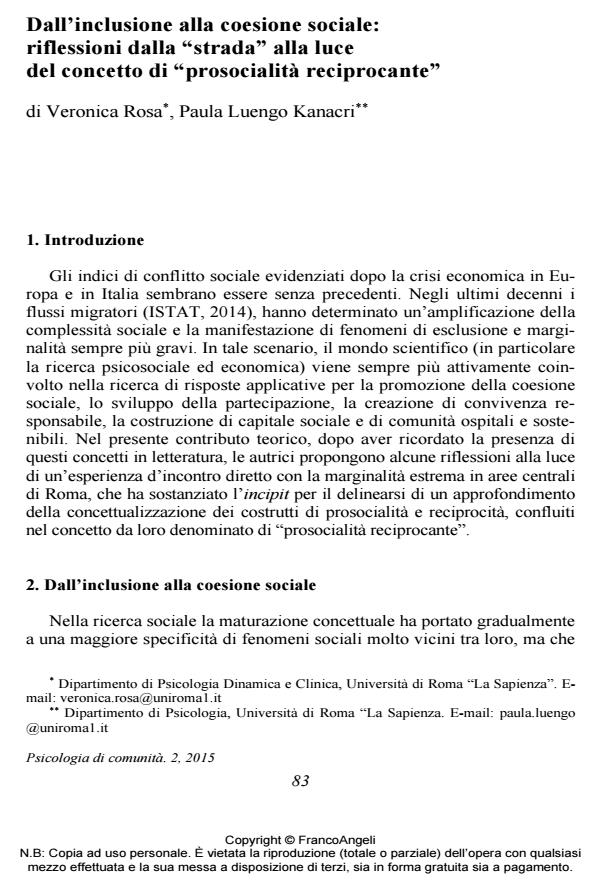From inclusion to social cohesion: reflections from the "street" to light of "reciprocating prosociality" concept
Journal title PSICOLOGIA DI COMUNITA’
Author/s Veronica Rosa, Paula Luengo Kanacri
Publishing Year 2015 Issue 2015/2 Language Italian
Pages 10 P. 83-92 File size 41 KB
DOI 10.3280/PSC2015-002007
DOI is like a bar code for intellectual property: to have more infomation
click here
Below, you can see the article first page
If you want to buy this article in PDF format, you can do it, following the instructions to buy download credits

FrancoAngeli is member of Publishers International Linking Association, Inc (PILA), a not-for-profit association which run the CrossRef service enabling links to and from online scholarly content.
The contribution was born from the desire of the authors to emphasize the role of a "reciprocating prosociality" in predicting inclusiveness and social cohesion. The "reciprocating prosociality" means to put in action bidirectional and circular behaviors, by ensuring the conditions in which who receives a benefit is also able to "reciprocate". This is what has been experienced by the authors in an ongoing project carried out in collaboration with other volunteers working with extremely marginalized homeless people in Rome. The authors are engaged in "bringing research questions on these issues on the street , in order to begin to grasp answers from the people’s narratives and build relationships that can generate a responsible and cohesive "living-together".
Keywords: Social inclusion, social cohesion, reciprocating prosociality, extreme marginality, responsible living together, social support networks.
- Avallone F., Farnese M.L., Pepe S. e Paplomatas A. (2007). Il processo di convivenza. Rassegna di Psicologia, 1: 9-33.
- Bárcena A., Prado A., Beccaria L. and Malchik S. (2010). Social Cohesion in Latin America. Concepts, frames of reference and indicators, New York: United Nations.
- Bartlett M.Y. and DeSteno D. (2006). Gratitude and prosocial behavior helping when it costs you. Psychological Science, 17(4): 319-325. DOI: 10.1111/j.1467-9280.2006.01705.
- Bruni L. (2006). Reciprocità. Dinamiche di cooperazione, economia e società civile. Milano: Mondadori.
- Bruni L. (2014). Ricchezze. Cinisello Balsamo (MI): San Paolo.
- De Tezanos-Pinto P., Bratt C. and Brown R. (2010). What will the others think? In-group norms as a mediator of the effects of intergroup contact. British Journal of Social Psychology, 49, 3: 507-523. DOI: 10.1348/014466609X47102
- Durkheim E. (1893). The Division of Labor in Society. Trans. W.D. Halls, New York: Free Press.
- Eisenberg N., Spinrad T.L. and Knafo A. (2014). Prosocial development. In: Lamb M. and Lerner R.M., editors, Handbook of child psychology and developmental science, 7th ed., Vol. 3. Socioemotional processes. New York: Wiley.
- European Committee for Social Cohesion (2004).
- Fehr E. and Falk A. (2002). Psychological foundations of incentives. European Economic Review, 46:687-724. DOI: 10.1016/S0014-2921(01)00208-
- Francescato D. e Tomai M. (2005). Psicologia di comunità e mondi del lavoro. Sanità, pubblica amministrazione e privato sociale. Roma: Carocci.
- Gleason M.E.J., Masumi I., Shrout P.E. and Bolger N. (2008). Receiving support as a mixed blessing: Evidence for dual effects of support on psychological outcomes. Journal of Personality and Social Psychology, 94(5): 824-838. DOI: 10.1037/0022-3514.94.5.82
- Green A., Preston J. and Sabates R. (2003). Education, equality and social cohesion: A distributional approach. Compare, 33(4): 453-470. DOI: 10.1080/030579203200012775
- ISTAT (2014). Testo disponibile al sito: http://www.istat.it/it/immigrati, Rome.
- Kankanhalli A., Tan B.C.Y. and Wei K.K. (2005). Contributing knowledge to electronic knowledge repositories: An empirical investigation. MIS Quarterly, 29(1): 113-143.
- Marta E. e Scabini E. (2003). Giovani volontari. Firenze: Giunti.
- Marzana D. (2011). Volontari si diventa. Milano: Vita & Pensiero.
- Novara C. (2014). Psicologia di comunità e sistemi di reciprocità: Soluzioni “inusuali” per fronteggiare la crisi. In: Atti 10 Convegno Nazionale SIPCO, 19-21, a cura di, Mazzoni D., Prati G., Cicognani E. and Albanesi C., Costruire Comunità Ospitali e Sostenibili, pp. 161-162.
- Omoto A.M., Snyder M. and Martino S.C. (2000). Volunteerism and the life course: Investigating agerelated agendas for action. Basic and Applied Social Psychology, 22: 181-198. DOI: 10.1207/S15324834BASP2203_
- Roche O.R. (2002). L’intelligenza prosociale. Imparare a comprendere e comunicare i sentimenti e le emozioni. Milano: Centro Studi Erikson.
- Staub E. (1979). Positive social behavior and morality: Socialization and Development. Vol. 2. New York: Academic Press.
- UNDP (2013). Understanding Social Conflict in Latin America, Brief Report. PAPEP/UNDP: La Paz.
- Wang C.-C. and Wang C.-H. (2008). Helping others in online games: Prosocial behavior in cyberspace. Cyber Psychology e Behavior, 11, 3:344-346. DOI: 10.1089/cpb.2007.004
- Zamagni S. (2013). Per un’economia a misura di persona. Roma: Città Nuova.
- Zanghì G. (2004). Dio che è amore. Roma: Città Nuova.
Veronica Rosa, Paula Luengo Kanacri, Dall’inclusione alla coesione sociale: riflessioni dalla "strada" alla luce del concetto di "prosocialità reciprocante" in "PSICOLOGIA DI COMUNITA’" 2/2015, pp 83-92, DOI: 10.3280/PSC2015-002007